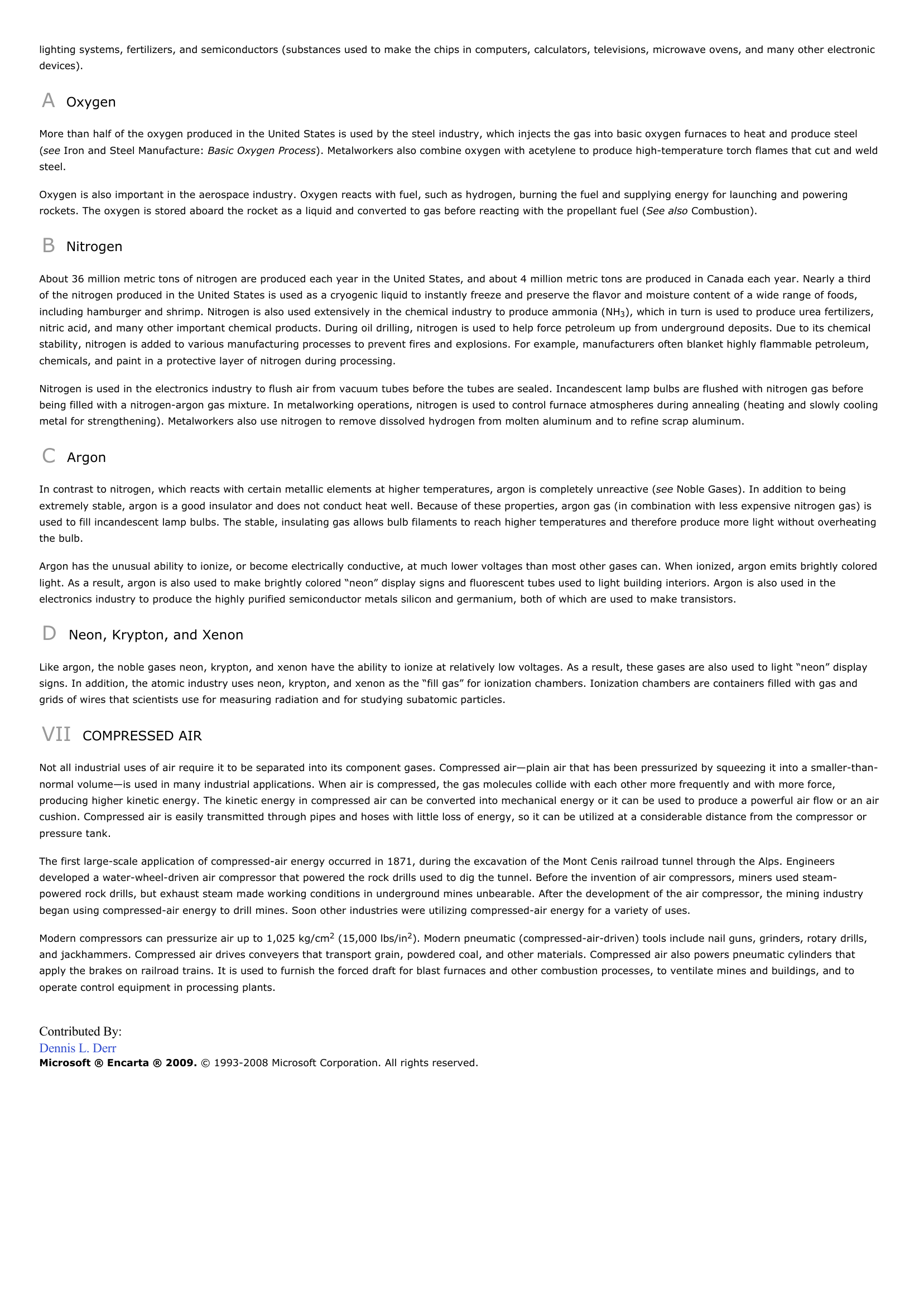Air - chemistry.
Publié le 11/05/2013

Extrait du document
«
lighting systems, fertilizers, and semiconductors (substances used to make the chips in computers, calculators, televisions, microwave ovens, and many other electronicdevices).
A Oxygen
More than half of the oxygen produced in the United States is used by the steel industry, which injects the gas into basic oxygen furnaces to heat and produce steel(see Iron and Steel Manufacture: Basic Oxygen Process ).
Metalworkers also combine oxygen with acetylene to produce high-temperature torch flames that cut and weld steel.
Oxygen is also important in the aerospace industry.
Oxygen reacts with fuel, such as hydrogen, burning the fuel and supplying energy for launching and poweringrockets.
The oxygen is stored aboard the rocket as a liquid and converted to gas before reacting with the propellant fuel ( See also Combustion).
B Nitrogen
About 36 million metric tons of nitrogen are produced each year in the United States, and about 4 million metric tons are produced in Canada each year.
Nearly a thirdof the nitrogen produced in the United States is used as a cryogenic liquid to instantly freeze and preserve the flavor and moisture content of a wide range of foods,including hamburger and shrimp.
Nitrogen is also used extensively in the chemical industry to produce ammonia (NH 3), which in turn is used to produce urea fertilizers, nitric acid, and many other important chemical products.
During oil drilling, nitrogen is used to help force petroleum up from underground deposits.
Due to its chemicalstability, nitrogen is added to various manufacturing processes to prevent fires and explosions.
For example, manufacturers often blanket highly flammable petroleum,chemicals, and paint in a protective layer of nitrogen during processing.
Nitrogen is used in the electronics industry to flush air from vacuum tubes before the tubes are sealed.
Incandescent lamp bulbs are flushed with nitrogen gas beforebeing filled with a nitrogen-argon gas mixture.
In metalworking operations, nitrogen is used to control furnace atmospheres during annealing (heating and slowly coolingmetal for strengthening).
Metalworkers also use nitrogen to remove dissolved hydrogen from molten aluminum and to refine scrap aluminum.
C Argon
In contrast to nitrogen, which reacts with certain metallic elements at higher temperatures, argon is completely unreactive ( see Noble Gases).
In addition to being extremely stable, argon is a good insulator and does not conduct heat well.
Because of these properties, argon gas (in combination with less expensive nitrogen gas) isused to fill incandescent lamp bulbs.
The stable, insulating gas allows bulb filaments to reach higher temperatures and therefore produce more light without overheatingthe bulb.
Argon has the unusual ability to ionize, or become electrically conductive, at much lower voltages than most other gases can.
When ionized, argon emits brightly coloredlight.
As a result, argon is also used to make brightly colored “neon” display signs and fluorescent tubes used to light building interiors.
Argon is also used in theelectronics industry to produce the highly purified semiconductor metals silicon and germanium, both of which are used to make transistors.
D Neon, Krypton, and Xenon
Like argon, the noble gases neon, krypton, and xenon have the ability to ionize at relatively low voltages.
As a result, these gases are also used to light “neon” displaysigns.
In addition, the atomic industry uses neon, krypton, and xenon as the “fill gas” for ionization chambers.
Ionization chambers are containers filled with gas andgrids of wires that scientists use for measuring radiation and for studying subatomic particles.
VII COMPRESSED AIR
Not all industrial uses of air require it to be separated into its component gases.
Compressed air—plain air that has been pressurized by squeezing it into a smaller-than-normal volume—is used in many industrial applications.
When air is compressed, the gas molecules collide with each other more frequently and with more force,producing higher kinetic energy.
The kinetic energy in compressed air can be converted into mechanical energy or it can be used to produce a powerful air flow or an aircushion.
Compressed air is easily transmitted through pipes and hoses with little loss of energy, so it can be utilized at a considerable distance from the compressor orpressure tank.
The first large-scale application of compressed-air energy occurred in 1871, during the excavation of the Mont Cenis railroad tunnel through the Alps.
Engineersdeveloped a water-wheel-driven air compressor that powered the rock drills used to dig the tunnel.
Before the invention of air compressors, miners used steam-powered rock drills, but exhaust steam made working conditions in underground mines unbearable.
After the development of the air compressor, the mining industrybegan using compressed-air energy to drill mines.
Soon other industries were utilizing compressed-air energy for a variety of uses.
Modern compressors can pressurize air up to 1,025 kg/cm 2 (15,000 lbs/in 2).
Modern pneumatic (compressed-air-driven) tools include nail guns, grinders, rotary drills, and jackhammers.
Compressed air drives conveyers that transport grain, powdered coal, and other materials.
Compressed air also powers pneumatic cylinders thatapply the brakes on railroad trains.
It is used to furnish the forced draft for blast furnaces and other combustion processes, to ventilate mines and buildings, and tooperate control equipment in processing plants.
Contributed By:Dennis L.
DerrMicrosoft ® Encarta ® 2009. © 1993-2008 Microsoft Corporation.
All rights reserved..
»
↓↓↓ APERÇU DU DOCUMENT ↓↓↓
Liens utiles
- Droit public des biens - Commentaire d’arrêt Conseil d'Etat, 18 septembre 2015, société Prest’Air req. N° 387315
- T. C. 15 janv. 1968, COMPAGNIE AIR FRANCE c. ÉPOUX BARBIER, Rec. 789, concl. Kahn
- gr ammair e : la ponctuation Tu sépares les quatre phrases du texte suivant : Quand venait la nuit j'étais mort de fatigue je réduisais la voilure de ma grand voile je préparais mon deuxième repas de la journée l'air marin me donnait un appétit féroce.
- « Life is a self-replicating, evoluing system based on organic chemistry » Qu’est ce qui est vivant ?
- AIR DE L'EAU (L’) André Breton (résumé)


